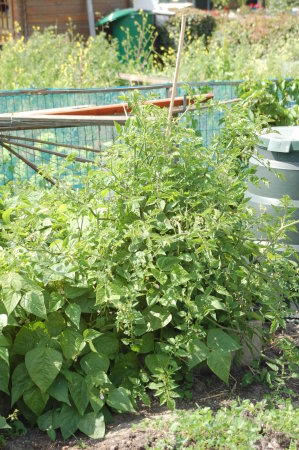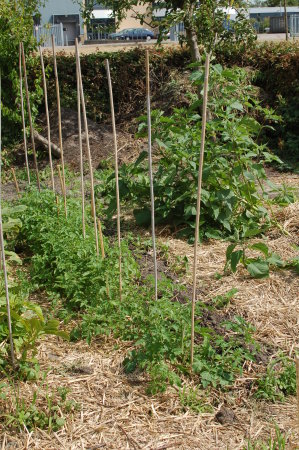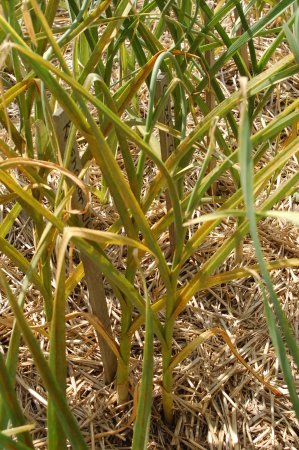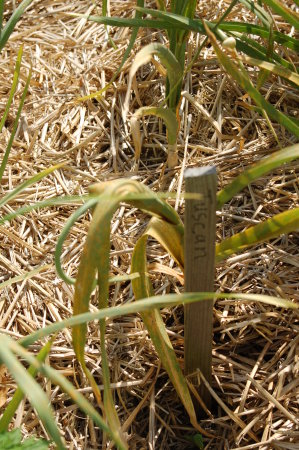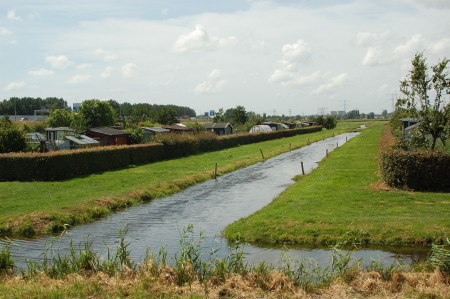
I’ve been meaning to do a post about the hedge in our garden for a while now, and it seemed like it would go along with the discussion on my post Wednesday about the dead ground and the cultural issues that go along with it.
Our garden complex includes four rows of gardens separated by canals like you see in this picture. All of the gardens are surrounded by a hedge. We are all responsible for maintaining the hedge that goes along the outside of our gardens, and I’m personally a bit screwed in this regard. Because I have a double garden on the end of a row, I have hedge on three sides totalling about 50 linear meters! Most gardens only have about 15 linear meters.
Since there is no electricity in the gardens, you certainly see a few gardeners starting up their gas (petrol) generators so they can plug in their electric hedge trimmers and trim their 15 meters of hedge (something that needs to be done every few weeks). Some of the more environmentally minded gardeners use battery operated trimmer they charge at home. Considering the maintenance and expense of the equipment involved, I don’t find there is much benefit to powered trimmers, so I just use a hand shears. This is a bit time consuming, but not really a huge deal once it comes down to it.
The hedge is a constant source of irritation for most gardeners. There are rules governing exactly how high the hedge must be, and the state it has to be kept in. The management of the garden comes along regularly inspecting and enforcing these rules. If you don’t take care of your hedge, they can fine you or bill you for the cost of taking care of it for you, and eventually you will lose your garden. For gardens on the south side it means a shadow is cast on that part of their garden. For all of us, the size of our gardens is calculated including the hedge and we pay for that space every year. The hedge is nitrogen fixing, meaning it grows quickly and is a major source of weeds. We all have to spend considerable effort fighting these weeds and maintaining barriers on the ground. It’s also sometimes home to birds and other wildlife that are often garden pests.
You can see when it comes down to it some of us are better at taking care of it than others, like the bit in the middle of the picture above which is just growing wild. Really it just never looks good, if you stand back and look at it as a whole.
One of the issues I personally have with the hedge is I needed to do a rather major cutting back when I first got my garden, and the space it needed in my compost pile was almost more than I had available.
The grass on the outside is also a similar issue, as we all need to take turns mowing it.
So the obvious question is if everyone hates it so much why don’t we get rid of it? The answer is we can’t.
The garden complex was built on a piece of land which probably used to be used for grazing animals, so it was just open space. Some overpaid civil servant, who has probably never had a garden and probably no idea how much of an irritation it would be to many of the people using the space, set about to do some urban planning. With pencil and paper, and lots of committee meetings and associated paperwork, decided exactly how our garden complex would look. They laid out the grass on the side, and choose the kind of plants used to make the hedge. They laid out the size and shape of all our gardens.
These civil servants who do this kind of work in this country are held in very high esteem. Often their names go along with their work, and sometimes they get to choose the names for the neighborhoods. Often for generations after this work is done, and consideration is being given to building something else in the spot, there are emotional public meetings where people express how painful it is to undo the work of the genius who created the spot in the first place.
I think even if all of us gardeners rioted on city hall, we would be unable to change the urban planning that went into that hedge or the grassy areas around our gardens. After all, what would really be the harm of putting up a row of trees to block the view from the street, then doing what we wanted with our gardens? Well this would be violating the idea here of not allowing individual expression.
We also have a similar problem with the security fence that surrounds our garden complex. There is a precise definition of a security fence in the Netherlands. It’s a little less than 2 meters high and strong enough to keep it from just being kicked down. It has to have a legally prescribed notice on it identifying it as a security fence, and if it is kept locked and someone breaches it, we can call the police and complain. The city planning forbids us from building a fence that is any higher than this, and we regularly have people that jump the fence and vandalize gardens. Realistically there is little the police can do, and we are not allowed to build a bigger fence to prevent the problem in the first place.
The situation is very straight forward. The city owns the garden complex and is letting us use it. If we don’t follow the rules, we will be fined and kicked out. If we don’t like the rules, we are welcome to go to another garden complex in another city, but similar rules exist everywhere. It’s not a matter of just going to a private garden complex and paying more, because there is probably no city in the Netherlands that would issue a zoning or use permit for someone to build and operate something like this.
In many neighborhoods the situation is similar if you own an apartment in a large building. While you might own your apartment, the city controls the appearance of the outside of the building and surrounding area, so there is nothing the occupants can do to change this. Even as a home owner in Amsterdam, there are rules about the color of paint I can use on the outside of my house, in particular plain white paint is absolutely forbidden.
I understand there are rules like this everywhere in the world, but I think they are really taken to an extreme here.




